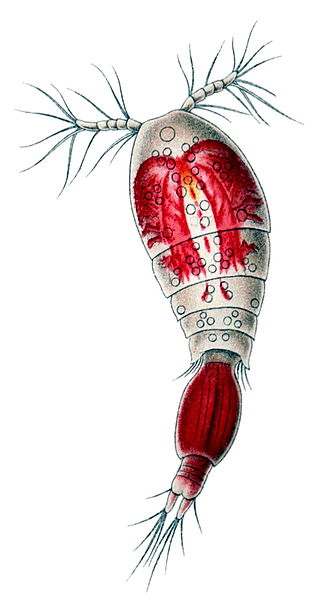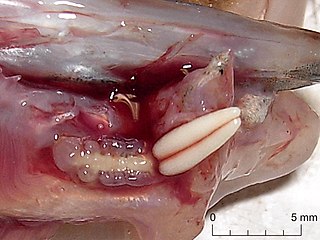
Tantulocarida is a highly specialised group of parasitic crustaceans that consists of about 33 species, treated as a class in superclass Multicrustacea. They are typically ectoparasites that infest copepods, isopods, tanaids, amphipods and ostracods.

The Cyclopoida are an order of small crustaceans from the subclass Copepoda. Like many other copepods, members of Cyclopoida are small, planktonic animals living both in the sea and in freshwater habitats. They are capable of rapid movement. Their larval development is metamorphic, and the embryos are carried in paired or single sacs attached to first abdominal somite.

Poecilostomatoida are an suborder of copepods. Although it was previously considered a separate order, recent research showed it to be nested within the Cyclopoida
Speleophria bivexilla is a species of copepod in the family Speleophriidae. It is endemic to Bermuda.
Speleophria is a genus of marine copepods in the family Speleophriidae. It contains the following species:

The Cyclopidae are a family of copepods containing more than half of the 1,200 species in the order Cyclopoida in over 70 genera.
Bomolochidae is a family of copepods parasitic on marine fishes. Most species parasitize the gills of fish, but some species live in the nostrils or on the eyes of their hosts. The family contains just over 150 species from the following genera:

Acartiidae is a family of calanoid copepods distinguishable by the rostral margin not being extended. They are epipelagic, planktonic animals, not being found below a depth of 500 metres (1,600 ft). There are over 100 described species distributed throughout the world's oceans, mainly in temperate areas.
Paralubbockia longipedia is a species of copepod, and the only member of the family Paralubbockiidae. The family is characterised by the ventral position of the fifth legs, the possession of a separate maxillary palp, and the form of the endopods of the legs and antennae. The closest relatives of Paralubbockia are the family Oncaeidae. Initially placed among the Poecilostomatoida, Paralubbockia is now considered part of the Cyclopoida.

Oncaea is a genus of copepods. The genus contains bioluminescent species. Unlike other bioluminescent copepods, Oncaea have an internal (non-secreted) bioluminescence. Oncaea contains the following species:
Clausiidae is a family of parasitic copepods of the suborder Poecilostomatoida, comprising the following genera:

Temoridae is a family of copepods, containing the following genera:
Speleophriidae is a family of copepods, comprising seven genera. All are restricted to anchialine caves, with the exception of Archimisophria, which is found in the hyperbenthos of the depths of the Atlantic Ocean. The genera are:
Nicothoe is a genus of copepods, containing the following species:
Metridinidae is a family of copepods, comprising three genera – Gaussia, Metridia and Pleuromamma. It has also been referred to as "Metridiidae", but following a petition to the International Commission on Zoological Nomenclature, that name has been restricted to the family Metridiidae Carlgren, 1893, based on the anthozoan genus Metridium. All species in the family can produce blue-green bioluminescence; the light is produced in glands, whose position varies between genera.
Pseudocyclopiidae is a family of copepods, comprising the following genera:
Augaptilidae is a family of copepods, comprising the following genera:

Acanthochondria limandae is a species of copepods in the genus Acanthochondria. They are host-specific ectoparasites of two species of flatfish: the common dab and the European flounder. They attach themselves to the bases of the gill arches of their hosts. They can infest as much as 2 to 30% of fish in a given population.

Eurytemora is a genus of copepods in the family Temoridae. The World Register of Marine Species lists the following species:

Misophriidae is a family of copepods belonging to the order Misophrioida.









